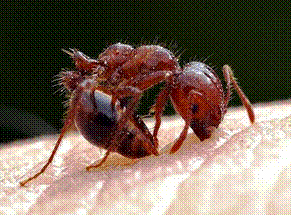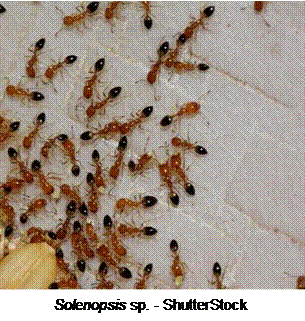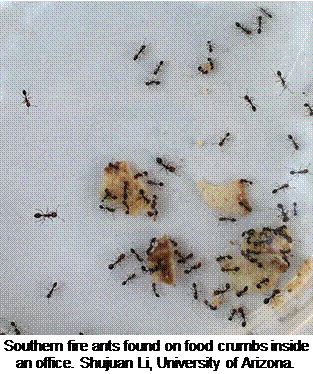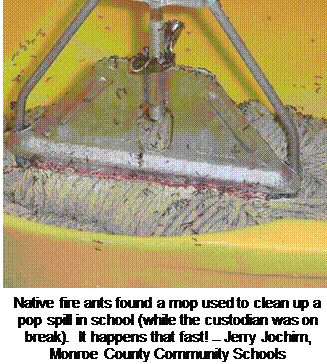Ants are the most common school pests in many states and their presence frequently stimulates both necessary and unnecessary pesticide applications. By far the most notorious of all ant pests to cause havoc around homes, schools, childcare
facilities and any facility with playgrounds or landscaped areas are the:
| Class:Insecta Order:Hymenoptera Family:Formicidae Genus:Solenopsis |
While there are nearly 300 species in the cosmopolitan Solenopsis Genus, relatively few are pest species, but those that achieve pest status are infamous due to their ability to inflict a notable sting.
Here at the University of Arizona our go-to-guy on all things that sting is Adjunct Scientist and author of “The Sting of the Wild” Dr. Justin Schmidt. Justin in boldly conducting his research has been stung by many insects, and has accordingly compiled 83 different sting experience reports, attributing a Schmidt Sting Pain Index to each. Our native fire ants register a 1 on the Schmidt Sting Pain Index (SSPI), and even Red Imported Fire Ants and Black Imported Fire Ants don’t rate any different. Ant species feature high on Justin’s top 10 most painful sting experiences, and he gives the top most painful 4 out of 4 spot to the Central and South American bullet ant.
 Justin describes native fire ants as a common nuisance to anyone with a yard, but judges their venom to be relatively mild. If stung by a native fire ant Justin says that you can expect a sting to be “sharp, sudden, mildly alarming.
Like walking across a shag carpet and reaching for the light switch.” Red imported fire ants are more aggressive and a higher number of stings may occur very quickly. Fire ant venom contains alkaloid compounds called piperidines that are
quite frankly super nasty toxins. Piperidines are neurotoxic (altering the normal activity of nerves), cytotoxic (causing cell damage), and hemotoxic (destroying red blood cells and causing tissue damage). Piperidine compounds in the venom
of different species are unique to that species, so reactions differ accordingly. Red imported fire ant stings quite commonly cause pseudopustules (blisters full of sterile tissue serum) to form, while native fire ant stings typically do not,
or they are less far severe.
Justin describes native fire ants as a common nuisance to anyone with a yard, but judges their venom to be relatively mild. If stung by a native fire ant Justin says that you can expect a sting to be “sharp, sudden, mildly alarming.
Like walking across a shag carpet and reaching for the light switch.” Red imported fire ants are more aggressive and a higher number of stings may occur very quickly. Fire ant venom contains alkaloid compounds called piperidines that are
quite frankly super nasty toxins. Piperidines are neurotoxic (altering the normal activity of nerves), cytotoxic (causing cell damage), and hemotoxic (destroying red blood cells and causing tissue damage). Piperidine compounds in the venom
of different species are unique to that species, so reactions differ accordingly. Red imported fire ant stings quite commonly cause pseudopustules (blisters full of sterile tissue serum) to form, while native fire ant stings typically do not,
or they are less far severe.
 How does
that all feel? Well irrespective of fire ant species it feels rather like a burning sensation. But the most significant risk associated with both native and imported fire ants is not the sting but potential hypersensitivity allergy
responses which can be life-threatening. People vary greatly in their sensitivity to stings. Some may experience short-term sting-site discomfort, while others may be hypersensitive to venom or may have medical conditions (e.g., heart
condition, diabetes) that can result in serious medical complications. Individuals with a history of severe allergic reactions to wasp, bee or ant stings should consider carrying an epinephrine auto injector (EpiPen) and should
wear a medical identification bracelet or necklace stating their allergy. Around 1% of children and 3% of adults are allergic to Hymenopteran (bees, wasps, and ants) insect stings making fire ants a high priority pest for school and childcare
facility managers.
How does
that all feel? Well irrespective of fire ant species it feels rather like a burning sensation. But the most significant risk associated with both native and imported fire ants is not the sting but potential hypersensitivity allergy
responses which can be life-threatening. People vary greatly in their sensitivity to stings. Some may experience short-term sting-site discomfort, while others may be hypersensitive to venom or may have medical conditions (e.g., heart
condition, diabetes) that can result in serious medical complications. Individuals with a history of severe allergic reactions to wasp, bee or ant stings should consider carrying an epinephrine auto injector (EpiPen) and should
wear a medical identification bracelet or necklace stating their allergy. Around 1% of children and 3% of adults are allergic to Hymenopteran (bees, wasps, and ants) insect stings making fire ants a high priority pest for school and childcare
facility managers.
When it comes to eliminating fire ants we call Auburn University fire ant expert Dr. Lawrence
 “Fudd”
Graham. If we called him now declaring a fire ant frenzy, he’d remind us that we should have been scouting fields and taking the matter in-hand a few months ago. For schools which do shut down for the summer, that’s the ideal
time to check turf and remediate hotspots before they get out of hand and before students return to school.
“Fudd”
Graham. If we called him now declaring a fire ant frenzy, he’d remind us that we should have been scouting fields and taking the matter in-hand a few months ago. For schools which do shut down for the summer, that’s the ideal
time to check turf and remediate hotspots before they get out of hand and before students return to school.
Here are some critically important management tips from fire ant experts:
1. Identify your ants, most ants are beneficial and should not be eliminated.Also, using an inappropriate control method for an ant pest can make the problem worse.
2. “Red ants”, “piss ants” or “sugar ants” are not specific ants, but rather general terms used to refer to unidentified troublesome ants.Unidentified ant presence is not enough information to determine what needs to be done, if anything (see point 1).
3. There may be lots of worker ants, but few queen ants, and they don’t tend to wonder around much above ground.You can spray a contact pesticide and kill a lot of worker ants, but unless you are modifying the environment to make the ants unwelcome and/or baiting you are not managing your ants. Ants share their food between individuals in the colony, and bait formulations exploit this behavior. Your goal should be to have the worker ants collect the toxic bait, and happily carry it back to the colony and deliver it to queen.
When it comes to fire ants there are fast-acting, slow-acting and combination bait options. Baits that have active ingredients that kill the adult workers are the fastest. If you are in a hurry, a fast acting bait product with indoxacarb (e.g. Advion®) will usually work in 3-10 days. Baits with hydramethylnon (e.g. Amdro® and Amdro® Pro ), spinosad (e.g. Fertilome® Come and Get It!, Green Light® 21029 Fire Ant Control With Conserve and Payback® Fire Ant Bait), or abamectin (e.g. Ascend® and Award® II) will work within 1-4 weeks. Baits with insect growth regulators, such as methoprene (e.g. Extinguish® Professional) or pyriproxyfen (e.g. Distance®) as active ingredients work slower and take 1-2 months to work, but tend to provide longer control. Extinguish® Plus is a mixture of hydramethylnon and methoprene. It usually produces results in 1-4 weeks, but the addition of the growth regulator tends to provide longer control than hydramethylnon alone. If you get well organized you can use extremely inexpensive, long-lasting baits that manage the problem very well with minimal applications. If the area is small, individual mound treatments will work. If the area is larger, broadcast applications of the bait are easier. During hot weather, do not apply bait until late in the afternoon. The Scotts® WizzTM Spreader is a battery operated handheld spreader, one of several helpful spreaders that can be used to apply granular bait.

To completely eliminate a colony, it is necessary to kill the egg-laying queen(s)
For more information about fire ant stings and how to treat them, read Fire Ant Stings on eXtension.
To learn more about treating anaphylactic shock and first aid in an emergency situation click here.
To learn more about fire ant lifecycles and biology click here.
Submitted by Dawn H. Gouge, University of Arizona & Lawrence “Fudd” Graham, Auburn University.